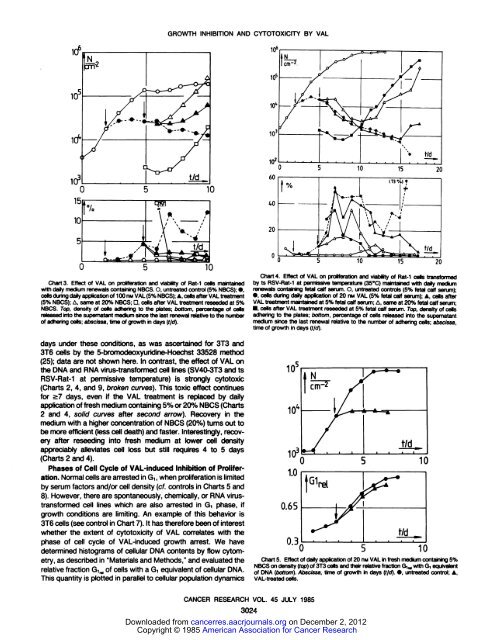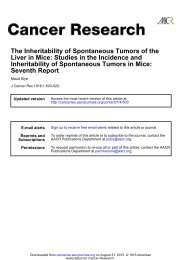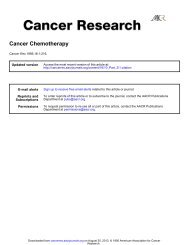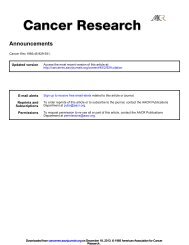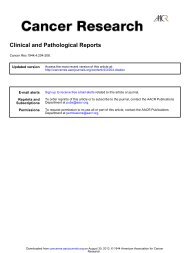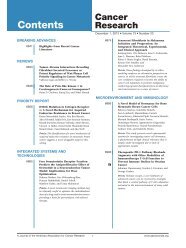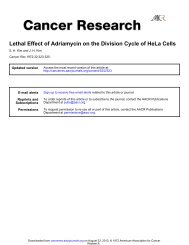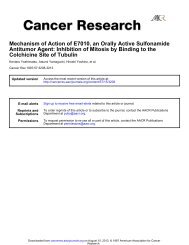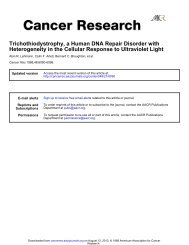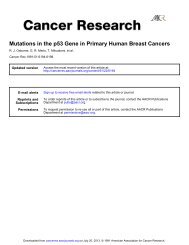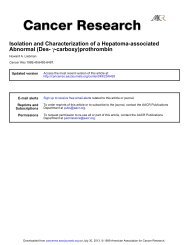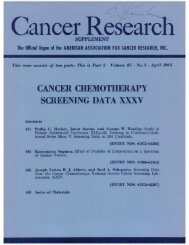Selective Effects by Valinomycin on Cytotoxicity ... - Cancer Research
Selective Effects by Valinomycin on Cytotoxicity ... - Cancer Research
Selective Effects by Valinomycin on Cytotoxicity ... - Cancer Research
You also want an ePaper? Increase the reach of your titles
YUMPU automatically turns print PDFs into web optimized ePapers that Google loves.
GROWTH INHIBITION AND CYTOTOXICITY BY VAL<br />
Chart 3. Effect of VAL <strong>on</strong> proliferati<strong>on</strong> and viability of Rat-1 cells maintained<br />
with daily medium renewals c<strong>on</strong>taining NBCS. O, untreated c<strong>on</strong>trol (5% NBCS); •,<br />
cells during daily applicati<strong>on</strong> of 100 nM VAL (5% NBCS); A, cells after VAL treatment<br />
(5% NBCS); A, same at 20% NBCS; D, cells after VAL treatment reseeded at 5%<br />
NBCS. Top. density of cells adhering to the plates; bottom, percentage of cells<br />
released into the supernatant medium since the last renewal relative to the number<br />
of adhering cells; abscissa, time of growth in days (t/d).<br />
days under these c<strong>on</strong>diti<strong>on</strong>s, as was ascertained for 3T3 and<br />
3T6 cells <str<strong>on</strong>g>by</str<strong>on</strong>g> the 5-bromodeoxyuridine-Hoechst 33528 method<br />
(25); data are not shown here. In c<strong>on</strong>trast, the effect of VAL <strong>on</strong><br />
the DNA and RNA virus-transformed cell lines (SV40-3T3 and ts<br />
RSV-Rat-1 at permissive temperature) is str<strong>on</strong>gly cytotoxic<br />
(Charts 2, 4, and 9, broken curves). This toxic effect c<strong>on</strong>tinues<br />
for >7 days, even if the VAL treatment is replaced <str<strong>on</strong>g>by</str<strong>on</strong>g> daily<br />
applicati<strong>on</strong> of fresh medium c<strong>on</strong>taining 5% or 20% NBCS (Charts<br />
2 and 4, solid curves after sec<strong>on</strong>d arrow). Recovery in the<br />
medium with a higher c<strong>on</strong>centrati<strong>on</strong> of NBCS (20%) turns out to<br />
be more efficient (less cell death) and faster. Interestingly, recov<br />
ery after reseeding into fresh medium at lower cell density<br />
appreciably alleviates cell loss but still requires 4 to 5 days<br />
(Charts 2 and 4).<br />
Phases of Cell Cycle of VAL-induced Inhibiti<strong>on</strong> of Prolifer<br />
ati<strong>on</strong>. Normal cells are arrested in G,. when proliferati<strong>on</strong>is limited<br />
<str<strong>on</strong>g>by</str<strong>on</strong>g> serum factors and/or cell density (cf. c<strong>on</strong>trols in Charts 5 and<br />
8). However, there are sp<strong>on</strong>taneously, chemically, or RNA virus-<br />
transformed cell lines which are also arrested in d phase, if<br />
growth c<strong>on</strong>diti<strong>on</strong>s are limiting. An example of this behavior is<br />
3T6 cells (see c<strong>on</strong>trol in Chart 7). It has therefore been of interest<br />
whether the extent of cytotoxicity of VAL correlates with the<br />
phase of cell cycle of VAL-induced growth arrest. We have<br />
determined histograms of cellular DNA c<strong>on</strong>tents <str<strong>on</strong>g>by</str<strong>on</strong>g> flow cytometry,<br />
as described in "Materials and Methods," and evaluated the<br />
relative fracti<strong>on</strong> G1wof cells with a d equivalent of cellular DNA.<br />
This quantity is plotted in parallel to cellular populati<strong>on</strong> dynamics<br />
10<br />
106<br />
20<br />
Chart 4. Effect of VAL <strong>on</strong> proliferati<strong>on</strong> and viability of Rat-1 cells transformed<br />
<str<strong>on</strong>g>by</str<strong>on</strong>g> ts RSV-Rat-1 at permissive temperature (35°C)maintained with daily medium<br />
renewals c<strong>on</strong>taining fetal calf serum. O, untreated c<strong>on</strong>trols (5% fetal calf serum);<br />
•,cells during daily applicati<strong>on</strong> of 20 nM VAL (5% fetal calf serum); A, cells after<br />
VAL treatment maintained at 5% fetal calf serum; A, same at 20% fetal calf serum;<br />
•,cells after VAL treatment reseeded at 5% fetal calf serum. Top, density of cells<br />
adhering to the plates; bottom, percentage of cells released into the supernatant<br />
medium since the last renewal relative to the number of adhering cells; abscissa,<br />
time of growth in days (f/d).<br />
0.65<br />
CANCER RESEARCH VOL. 45 JULY 1985<br />
Chart 5. Effect of daily applicati<strong>on</strong> of 20 nM VAL in fresh medium c<strong>on</strong>taining 5%<br />
NBCS <strong>on</strong> density ((op) of 3T3 cells and their relative fracti<strong>on</strong> G,ra with G, equivalent<br />
of DNA (bottom). Abscissa, time of growth in days (f/o). •,untreated c<strong>on</strong>trol; A,<br />
VAL-treated cells.<br />
3024<br />
Downloaded from<br />
cancerres.aacrjournals.org <strong>on</strong> December 2, 2012<br />
Copyright © 1985 American Associati<strong>on</strong> for <strong>Cancer</strong> <strong>Research</strong><br />
10


